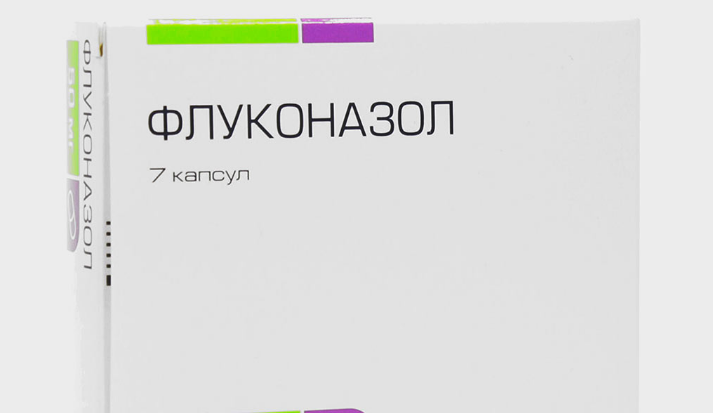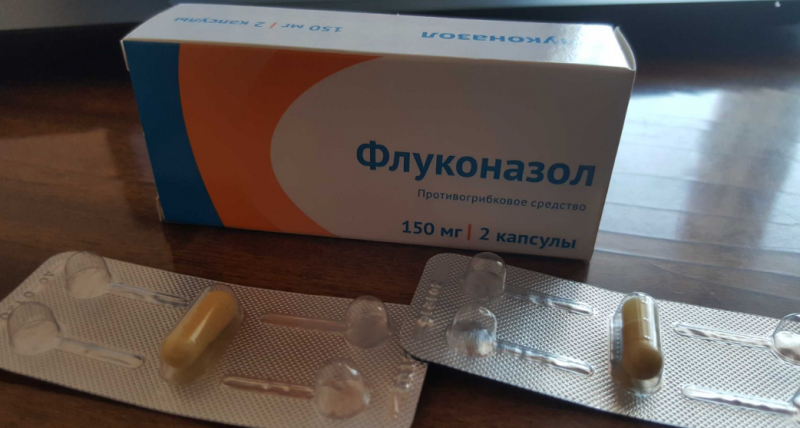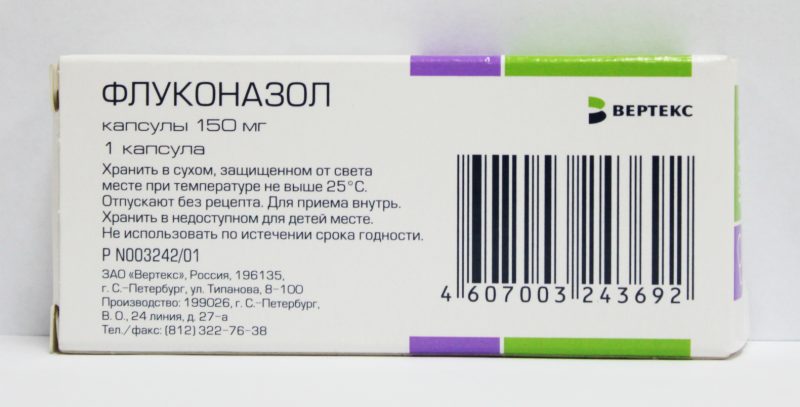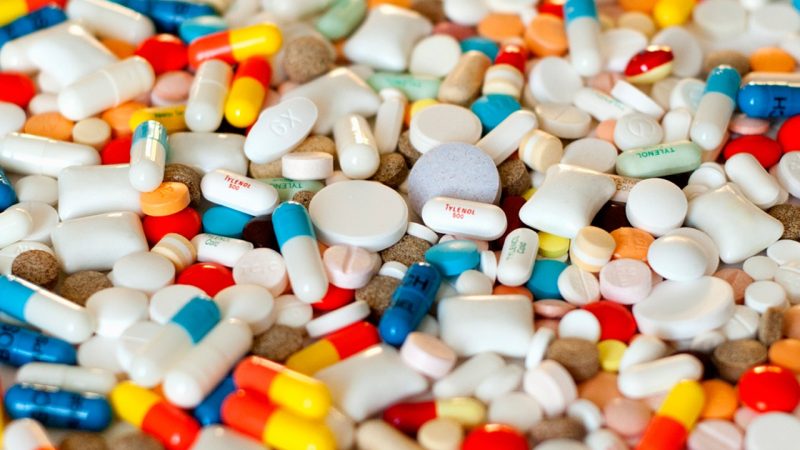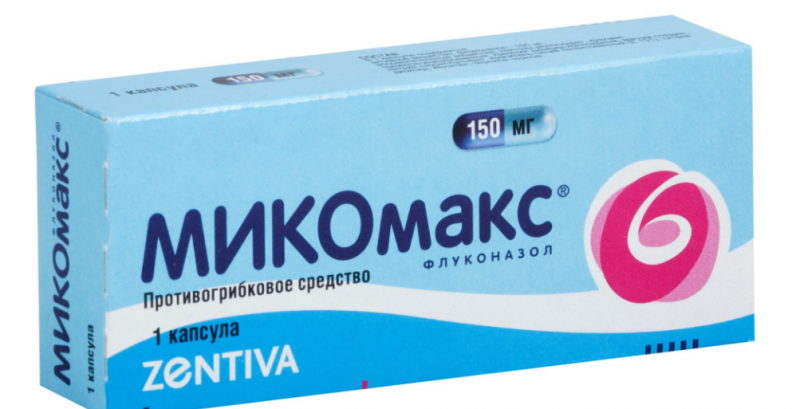The names of the drug groups often suggest which diseases they are used for. You can find out what Fluconazole is from the inscription on the package: “Antifungal agent”. An effective drug is prescribed for candidiasis of the mouth, esophagus, urinary tract and genitals.
Material Content:
- 1 Description of the dosage form, composition
- 2 Therapeutic effects, pharmacokinetics
- 3 Method of application, dosage
- 4 Special instructions for use
- 5 Prescription during pregnancy and lactation
- 6 Drug Interactions with Other Drugs
- 7 Contraindications, side effects and overdose
- 8 Analogues of the drug Fluconazole
Description of the dosage form, composition
The drug is released in the form of capsules, tablets and an infusion solution. The trade name coincides with the INN of the active substance (DV). Solid dosage forms contain 50, 100, 150 mg of fluconazole, less often - 200 mg. Capsules are produced by many pharmaceutical companies - Russian and foreign. Fluconazole tablets are produced in Ukraine.
The concentration of fluconazole in solutions is the same - 2 mg / ml. The volume of bottles with a liquid antifungal drug: 50, 100 or 200 ml.
Therapeutic effects, pharmacokinetics
"Fluconazole" is a synthetic antifungal or antimycotic agent. Most often, the drug is used to treat candidiasis, including the generalized form.
The cause of common diseases is microscopic yeast of the genus Candida. These are mainly C. albicans, C. parapsilosis, C. tropicalis. Also, DV eliminates the parasitic fungi that cause cryptococcosis, coccidiosis. "Fluconazole" acts against typical pathogens of mycoses of the skin and mucous membranes - microsporum, trichophyton.
The medicine in various forms of release acts fungistatically, that is, it inhibits the growth of fungi. "Fluconazole" blocks the synthesis of the enzyme in the cells of microorganisms sensitive to it. Metabolism is impaired, the strength of the cell membrane decreases. Fungal infection is more easily destroyed by the immune system.
"Fluconazole" has an advantage over some obsolete antifungal agents from the imidazole group. DV does not inhibit the synthesis of human liver enzymes, as is the case with clotrimazole and ketoconazole. However, fluconazole does not have a fungicidal effect like allylamines (terbinafine and naftififin).
Capsules and tablets are prescribed for various fungal infections:
- nail fungus;
- multi-colored lichen;
- candida balanitis;
- chronic cutaneous candidiasis;
- candidiasis of the mucous membranes and skin (not genital);
- vaginal candidiasis in acute and recurrent forms;
- dermatophytosis (fungus of the feet, limbs, trunk, head, inguinal region);
- acute disseminated candidiasis and other forms of invasive mycosis;
- generalized form of candidiasis, including candidaemia;
- cryptococcal meningitis;
- coccidioidomycosis.
"Oral fluconazole" is rapidly absorbed when taken orally, which occurs regardless of the presence or absence of food in the digestive tract. However, it is better to drink the medicine after eating. DV is absorbed in the intestine, enters the bloodstream, saliva. After 30 - 90 minutes, fluconazole begins to exhibit a fungistatic effect.
The concentration of the drug in biological fluids and body tissues is almost the same. Metabolism is insignificant, excretion of metabolic products occurs through the kidneys. A similar pharmacokinetics is observed with iv injections.
Method of application, dosage
You can start taking Fluconazole before the tests are completed and the results are obtained. After clarifying the cause of the malaise, the doctor adjusts the therapy or leaves it unchanged.
Dosages in the instructions for use:
- Genital candidiasis (thrush). Take 1 capsule of 150 mg or 3 pcs. 50 mg once. To reduce the risk of relapse, women should take 1 capsule of 150 mg per month. The course is from 4 months to 1 year.
- Fungus skin. Take 50 mg / day or 150 mg per week (once). The course is 28 days. Foot fungus is treated for 6 weeks.
- Onychomycosis. Drink 1 capsule per week (150 mg). The duration of treatment is up to 1 year.
- Candidiasis of the mucosa. Take the drug in the same way as with thrush. The course is from 7 to 14 days.
- Candidemia, invasive candidiasis. First, drink 2, 3 or 4 capsules of 100 mg (4 to 8 pcs. 50 mg). In the following days, take 200 mg / day. The total duration of the course is from 1 to 3 weeks.
"Fluconazole" with thrush can be drunk once.
Mild symptoms of the disease disappear after the first dose of the drug. However, the cause of vaginal candidiasis remains, because the source of yeast is in the intestines or in the skin. Therefore, a longer course of therapy is needed - up to 9 months.
Children, as well as adults, are prescribed to drink "Fluconazole" once a day, not more than 400 mg. Higher dosages and a longer course are recommended for patients with immunodeficiency.
Special instructions for use
Capsules are recommended to be swallowed whole. Any damage to the membrane causes the drug to be released early and destroyed by acid in the stomach. Tablets should also not be broken, as they are coated with a protective coating.
Treatment with "Fluconazole" must be carried out without changing its duration. If you stop taking the medicine earlier, then this can lead to relapse, since the infection will not be destroyed, there will remain foci.
During treatment, the toxic effect of fluconazole on the liver may be noted. After discontinuation of therapy, the work of the body is restored. If the patient's liver function is initially impaired, then the drug is prescribed in minimal doses.
Capsules and tablets are not suitable for treating young children.The doctor prescribes complete analogues, which are produced in the form of a soluble powder. The product is diluted with water and give the child a drink.
Prescription during pregnancy and lactation
Often, "Fluconazole" is drunk with the appearance of characteristic symptoms of thrush before visiting a doctor’s office. The benefit of drug treatment is without dangerous side effects. More caution should be exercised by women in position. A cause for concern is cases of spontaneous abortion among women who drank Fluconazole in the first trimester of pregnancy.
The drug passes into breast milk, but reaches lower concentrations, compared with plasma. "Fluconazole" or its analogues are prescribed for breastfeeding in doses up to 200 mg. If higher doses are required, then HB should be interrupted for the duration of treatment.
Drug Interactions with Other Drugs
The simultaneous use of fluconazole and several other antifungal agents is contraindicated.
Besides:
- Concomitant use with drugs that are metabolized in the liver is not recommended. These are quinidine, astemizole, pimozide,
- The negative effect on the heart increases with simultaneous treatment with fluconazole and erythromycin, cisapride and terfenadine.
- The metabolism of an antifungal agent is affected by hydrochlorothiazide, rifampicin.
- "Fluconazole", in turn, changes the effect of amitriptyline, alfentanil, amphotericin, anticoagulants azithromycin, benzodiazepines, carbamazepine, cyclosporine, fentanyl, oral contraceptives and other drugs.
Contraindications, side effects and overdose
"Fluconazole" is not used for allergies to DV and / or excipients. Adverse reactions include vomiting and diarrhea, convulsions. Rashes on the skin and mucous membranes, abdominal and headaches may appear. Very rarely, drug hepatitis and other liver dysfunctions, anaphylactic reactions develop. An overdose is dangerous because it leads to the appearance of hallucinations and paranoid behavior. In such cases, gastric lavage is required.
Analogues of the drug Fluconazole
Under the same and under other trade names, capsules and tablets are produced containing the same dose of DV. There are full analogues of "Fluconazole", which differ only in the second part of the name indicating the manufacturer (Stada, Teva, Sandoz, Vero, Canon, etc.). Some pharmaceutical companies produce the drug in a dosage of 200 mg (Sandoz and Kabi).
"Diflucan" (USA) - a line of medicines, the drug of which is also fluconazole. Among the release forms, there is the most suitable for babies - a suspension taken orally.
Other well-known analogues:
- "Diflason";
- "Flucostat";
- "Flucosan";
- "Flucoside";
- Mikomax;
- "Mikoflukan";
- "Mikosist."
Generics are 2 to 5 times cheaper than the original drugs.
"Fluconazole" - an antimycotic agent for oral administration, effective for thrush and other candidiasis, fungal diseases caused by dermatophytes. Indications, treatment regimens, side effects of the original drug and generics are almost the same.


